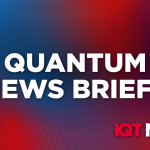QuEra’s “Apollo Program”

“AS11-40-5903 – Apollo 11” by Kevin M. Gill is licensed under CC BY 2.0.
https://openverse.org/image/
The Apollo Program landed American astronauts on the Moon and returned them safely to Earth. Based on 1950s precursors and developed throughout the 1960s, the Apollo guidance computer (AGC) was the heart of the Apollo Guidance, Navigation and Control system. With restrictions on space, weight, and power, the technology at the time allowed the AGC to have a high-density, read-only (ROM) rope memory equivalent to only 72 KB, a magnetic core erasable memory (RAM) equivalent to only 4 KB, and only 34 instructions. Most of the spacecraft’s operations relied on only 15 bits, while navigation relied on only 28 bits. Remarkably, a 1969 proposal to increase RAM to 32 KB “was rejected because of insufficient justification.” [https://ibiblio.org/apollo/
In other words, NASA engineers had to figure out how to complete a life-or-death mission with extremely limited nascent resources, especially when compared to modern technology. Efficiency was the key.
QuEra is not claiming to have the same life-or-death mission as NASA, but the recently announced Full-Stack Quantum Algorithm Co-Design Program is inspired by the Apollo Program.
Full-Stack. Co-Design.
Like the AGC of yesteryear, today’s quantum computers have limited nascent resources. QuEra’s program is about working with partners for 12-18 months on full-stack optimization: maximally efficient code, error correction, and so forth. If NASA could do what it did with what it had, what can QuEra do with what it has?
The key is the optimization at each level in the stack. Many in the industry are adding software layers that abstract away – hide – the technical details, enabling us to quickly and easily prototype applications that run everywhere. Unfortunately, these applications return suboptimal results everywhere. The AGC didn’t have the luxury of abstraction and accomplished the seemingly impossible, so QuEra’s idea is to forgo this abstraction as well, optimize the heck out of what they’ve got, and see what they can accomplish.
The program is a three-stage process. Step one is to analyze the problem together as partners, select an algorithm, and then write the code. Step two is to run it on a simulator, which QuEra is developing and is currently in closed beta. This simulator accounts for atom movements, atom losses, and other factors not addressed by off-the-shelf statevector simulators and tensor networks. Step three is to run on real hardware. At the end of the program, QuEra and partner(s) will have developed joint intellectual property (IP) around the problem. QuEra’s partnership with Los Alamos National Laboratory (LANL) has been made public, so that’s a space worth watching.
Analog vs Digital
QuEra currently boasts the largest publicly-available quantum computer: its 256-qubit “Aquila.” Aquila is an analog model device, which means that it doesn’t use the familiar quantum circuits and quantum gates to perform computation. It will remain available for the foreseeable future in its analog model, but it has a lesser-known younger sibling.
This sibling has an internal name of “Gemini,” which is interesting because the Gemini Program preceded the Apollo Program. However, “Gemini” is a popular name in both quantum and AI circles, so its name is subject to change.
Gemini uses the digital model, with its circuits and gates. This is the model that will be going to Japan in 2025 and is also the model that is the focus of this co-design program.
Conclusion
The industry’s goal is to have large-scale, fault-tolerant, universal quantum computers that can solve a wide range of problems. Progress is being made, but we’re not there yet. So, what if, on a case-by-case basis, we focused on solving one specific problem at a time? But let’s not focus just on the algorithm; let’s focus on the hardware implementing the algorithm, the code that is detecting and correcting errors, and everything else involved with the computation. We would end up having QuEra’s Full-Stack Quantum Algorithm Co-Design Program.
Epilogue
Among QuEra’s current partners, it’s interesting that LANL, home of America’s atomic program, is the one that has agreed to disclose its participation. Coincidentally, QuEra will be delivering a quantum computer to the National Quantum Computing Center (NQCC) in Harwell, home of the United Kingdom’s atomic program. So, while some say “quantum” needs its version of the Manhattan Project, QuEra’s actually starting to emulate one.


















